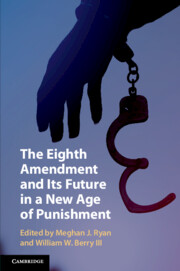Book contents
- The Eighth Amendment and Its Future in a New Age of Punishment
- The Eighth Amendment and Its Future in a New Age of Punishment
- Copyright page
- Dedication
- Contents
- Contributors
- Preface
- Introduction
- Part I A History of the Eighth Amendment
- Part II The Landscape of Eighth Amendment Doctrine
- 4 Eighth Amendment Values
- 5 The Power, Problems, and Potential of “Evolving Standards of Decency”
- 6 Judicial Hesitancy and Majoritarianism
- 7 Punishment Purposes and Eighth Amendment Disproportionality
- 8 The Administrative Law of the Eighth (and Sixth) Amendment
- 9 Evading the Eighth Amendment
- 10 Excessive Deference — The Eighth Amendment Bail Clause
- 11 Nor Excessive Fines Imposed
- Part III The Future of the Eighth Amendment
- Index
9 - Evading the Eighth Amendment
Prison Conditions and the Courts
from Part II - The Landscape of Eighth Amendment Doctrine
Published online by Cambridge University Press: 03 June 2020
- The Eighth Amendment and Its Future in a New Age of Punishment
- The Eighth Amendment and Its Future in a New Age of Punishment
- Copyright page
- Dedication
- Contents
- Contributors
- Preface
- Introduction
- Part I A History of the Eighth Amendment
- Part II The Landscape of Eighth Amendment Doctrine
- 4 Eighth Amendment Values
- 5 The Power, Problems, and Potential of “Evolving Standards of Decency”
- 6 Judicial Hesitancy and Majoritarianism
- 7 Punishment Purposes and Eighth Amendment Disproportionality
- 8 The Administrative Law of the Eighth (and Sixth) Amendment
- 9 Evading the Eighth Amendment
- 10 Excessive Deference — The Eighth Amendment Bail Clause
- 11 Nor Excessive Fines Imposed
- Part III The Future of the Eighth Amendment
- Index
Summary
The Eighth Amendment prohibition on “cruel and unusual punishment” places moral limits on what the state may do to people convicted of crimes. But because constitutional norms “are too vague to serve as rules of law,” courts need doctrinal standards to guide their analysis in concrete cases. In the American constitutional scheme, it falls to the Supreme Court to craft these standards.Translating constitutional values into workable rules will inevitably entail some cost to the full enforcement of those values, which makes the Court a site of ongoing struggle over the scope of constitutional protections. On paper, this struggle plays out in legal abstractions. Yet when the claimants are prisoners seeking to challenge the conditions of their confinement, the human stakes could not be higher. The greater the “slippage” between Eighth Amendment norms and their enforcement, the broader the judicial permission conferred on correctional officers to treat the incarcerated with cruelty — an effect that will cash out, every day, in increased physical suffering and psychological trauma for the real live flesh-and-blood people living in American prisons.
- Type
- Chapter
- Information
- The Eighth Amendment and Its Future in a New Age of Punishment , pp. 133 - 160Publisher: Cambridge University PressPrint publication year: 2020
- 2
- Cited by

